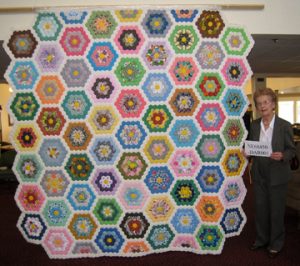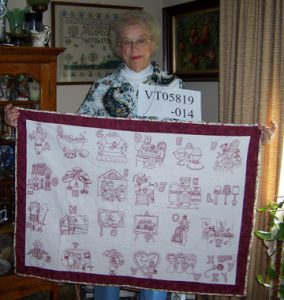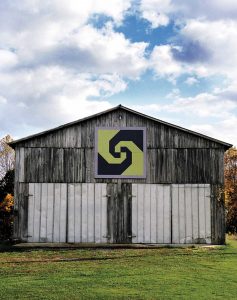Irene Fankhauser, interviewed by Sharon Ann Louden in Tecumseh, Nebraska in 2009.

Irene Fankhauser
SL: How do you think quilts are important for American life?
Mitzi Wiebe Oakes interviewed by Nola Forbes in South Burlington, Vermont in 2009.

Mitzi Wiebe Oakes
MO: I did a lot of small quilts to get through the Katrina hurricane, where my daughter’s house was destroyed. She was in desperate need of having small quilts for the hospital. I made as many as possible. And also did the quilt guild. We sent, I think, over seventy quilts to New Orleans.
MO: I do have trouble letting go of my quilts. They all represent something about my life or me at the time I do them. They really do tell a story about my life.
Donna Sue Groves interviewed by Karen Musgrave in Columbus, Ohio in 2008.

DG: I thought that it would grow, it would probably grow out throughout the Appalachian region, the thirteen states. Really never thought so much about the United States in 2001, and it growing that big, but what’s interesting is now that for the last seven years, and I’ve watched it go into Iowa and Missouri and Kansas and Indiana and Illinois and Kentucky, West Virginia, Virginia. As I’ve watched it grow and participated in that growth, I’ve come to realize that what I didn’t realize before, that rural people, in our rural lands, the places that people settled with their families and on small farms, are truly the backbone of America, and that we’re not so different from one another. I never thought about Iowa up until 2002. I never really gave a lot of thought about Illinois or Indiana. Now, when I hear the news of the great flooding that’s happening in Iowa or along the Mississippi, now I reflect and think about those folks. My life always has been, tied to other states, counties, but now I think about how really really flat we are and how we’re intertwined and connected together. You can take one project, Adams County, Ohio for example; you could take our project in 2001, teleport it to Mason County, West Virginia, right now. They’re planning theirs. They have their first quilt square up. You couldn’t tell the difference except the names have changed and maybe the shapes of the barns. We’re all one family, in a sense. We all have similar dreams, hopes, and aspirations.
KM: There’s power in quilting. I believe that.
DG: There is power in quilts. Everybody has a quilt story. Everybody remembers a quilt.

I appreciated reading your quilt stories… And, you’re right “Everyone has at least one quilt story”. I have many quilt stories, especially since I grew up on my family’s Georgia farm in the 1950-60’s. Yes, there is love in a quilt… pure and generous Love.